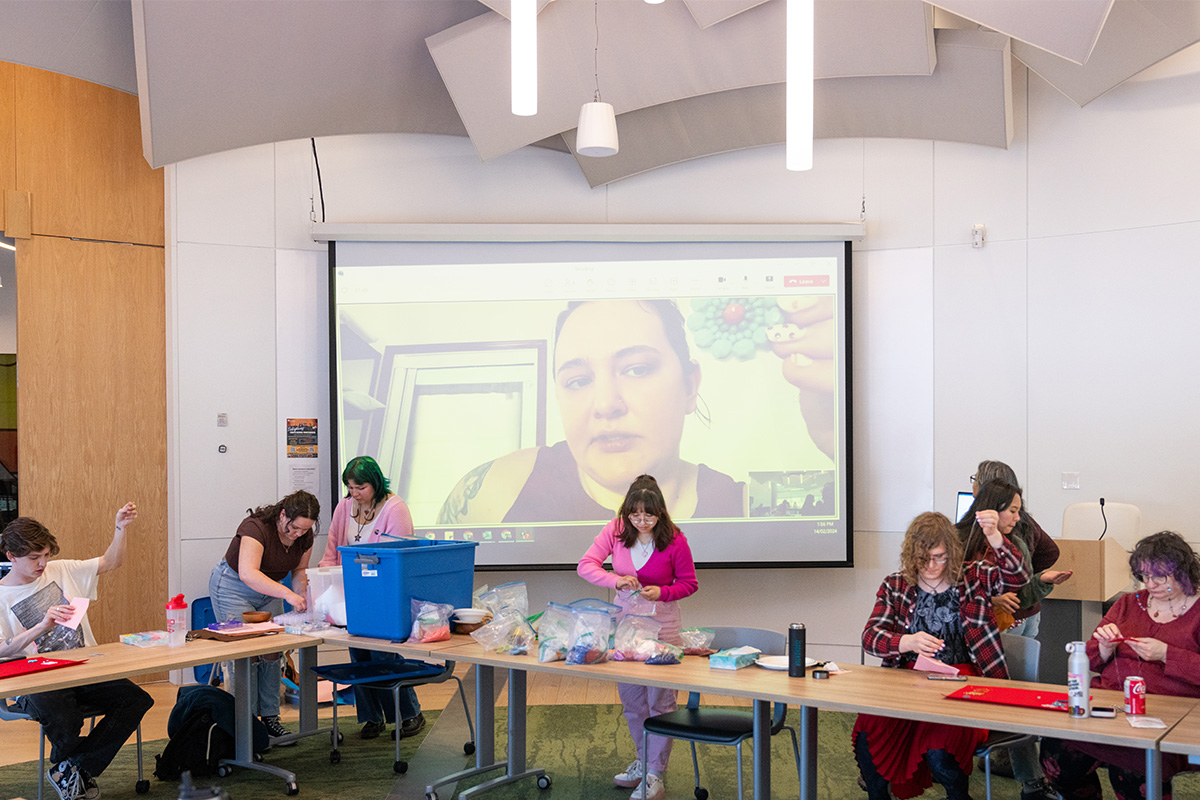Power dynamics are all around us, in nearly every relationship we engage in throughout our lives. They can help us achieve objectives, resolve conflict and build relationships. And while power can definitely have a dark side (manipulation and control), in many ways power dynamics are a necessary – and productive – part of our day-to-day interactions.
“Somebody's got to take charge,” says psychology prof Dr. Lynne Honey. “I think one of the most beautiful things about human personality is that we have all this variability, which allows there to be complementarity. You need some people who are going to step up, who are going to be bossy sometimes. If we were all exactly the same, that would be a nightmare.”
We asked five profs how power dynamics appear in their disciplines and research – from Aristotle to animals, from relationships to childcare and from health care to workplaces.
When it comes to defining the basic building blocks of power dynamics, philosophy prof Dr. Edvard Lorkovic looks to 4th-century BC Greek philosopher Aristotle.
For Aristotle, power is the capacity to achieve an end, explains Dr. Lorkovic. But it isn’t the only ingredient: that power must be realized. Aristotle refers to that realization as energeia. “In the famous example of the acorn, it has the capacity to turn into an oak tree, but it's not automatically an oak tree – the power has to be realized.”
When it comes to relationships and politics, that actualized power also needs to have authority.
“Authority is the correct, right, legitimate and just privilege of an office, and power is the brute ability to accomplish something,” explains Dr. Lorkovic. “You can have authority and have no power, or you can have power and authority.” It’s also possible for someone to have power without authority, or to extend their power beyond the legitimate bounds of their authority.
These two concepts come into play in power dynamics between people, including students and teachers. In those relationships, he says, a teacher has authority over a student. But if they didn’t have power – in the form of grading systems or being able to dole out punishments like detention – the students would have no reason to actually listen and learn from them, and wouldn’t benefit from the relationship.
Of course, there are nuances between those philosophical definitions and how they manifest themselves in reality.

Giving power to those who typically have none: children
Putting the power of learning into the hands of children is the focus of FLIGHT, Alberta’s Early Learning and Care curriculum framework, developed at MacEwan and implemented by Early Learning at MacEwan, as well as childcare facilities across the province. Dr. Lee Makovichuk’s research looks at how early educators use the framework, and ensures it remains relevant to children’s local experiences.
“Children make things happen in their play,” says the assistant professor in the Department of Early Learning and Curriculum Studies. “In early learning and care, we articulate this strong, capable, resourceful image of all children – we see them as people who can make choices in matters that concern them.”
With FLIGHT, the more traditional adult/child power dynamic shifts from the adult telling the child what to do, to the pair working together to explore what the child is learning and playing in their everyday experiences. Since children come from different backgrounds and family dynamics, their interests and what they learn can be incredibly diverse.
“One of the roles that educators have is to be a co-learner. What is this child interested in? And then we're co-researchers with them,” Dr. Makovichuk explains. When children take the lead, they feel empowered, important and intelligent.
Fostering interests that engage a group and focusing on individual outcomes is complex work. Dr. Makovichuk says early childhood educators are nurturing community members just as much as they are building individual people.
Childcare facilities are often a child’s first group experience outside of their homes. In honouring the practices of families and considering those practices together, early childhood educators support and encourage the natural diversity that already exists in society while also nurturing each child’s attachment to their family. These efforts are foundational to intercultural competence for all community members – educators, children and families, she says.
The FLIGHT framework considers best practices for ensuring that children have power over their own pursuits. Most recently, early childhood programs are showcasing different ways the framework can be applied in a series of videos filmed in childcare centres throughout the province, so educators can see how it can fit into their existing programming and structures.
“FLIGHT is a social-cultural framework. It's not the outcomes-based curriculum that we're most familiar with,” says Dr. Makovichuk. “It’s a guide. It presents some ideas for educators to think about in their practice, to adjust to the local community.”

How power dynamics can help you find a perfect match
Dr. Honey’s work with social dominance looks at differences in behavioural traits that correlate with individual power, and what levels of dominance are considered to be desirable in potential romantic partners. The idea of power in romance may spark assumptions of abuse or coercion, but the psychology prof notes that there are actually two different types of power in this scenario: dominance and prestige.
“Dominance-striving has a lot more to do with power, aggression, threats and controlling others’ behaviour. And so power in that context is about what you can make others do,” she explains. “Prestige-striving, however, has more to do with merit and respect. The individual who has highest prestige is someone who has earned it. It's not something that you take, it's something that is conferred upon you. They're independent, but they're not mutually exclusive ways to have power.”
Her research into social dominance dealt primarily with behavioural traits associated with both dominance and prestige, and how we perceive those traits for romantic partnerships. In one study, she looked at those who were good at decision-making and organizing plans for their less decisive partners. “It had a lot to do with how agentic the person was – how kickass were they? How much did they take charge of their environment?”
Dr. Honey and her student research assistants created fake dating profiles, with subjects ranging from cute, or just above average in appearance to very physically attractive. Their bios depicted different levels of dominance.
“We found that the socially dominant and cute combination had the highest ratings,” says Dr. Honey. “Whereas the hot but low dominance was very close to that. But low dominance and cute, or hot and dominant were much lower ratings of attractiveness. So people seem to want someone who is either hot or dominant, but not the two together.”
They also found that people generally tend to look for partners who are more dominant than they see themselves. Higher dominance levels in men were also viewed as more attractive than in women, but she notes that the effect wasn’t exceptionally strong.
Going forward, Dr. Honey is shifting her attention from social dominance in humans to our furry friends to look at the way dogs interact when they first greet each other. She’s interested in how their body language conveys their feelings toward one another and how it affects subsequent interactions.

Shifting dynamics in the workplace
In the realm of business, power dynamics are everywhere – between companies and consumers, small businesses and major corporations, and employers and employees. Even within those broad categories, smaller power dynamics come into play. That’s where Board of Governors Research Chair Dr. Albena Pergelova’s research comes in.
With her co-researchers from Thompson Rivers University, the associate professor in International Business, Marketing, Strategy and Law is working on a four-year Employment and Social Development Canada grant for their project “Building WISE (Work Integration Social Enterprises) for Black and Racialized Canadians: Evidence from British Columbia and Alberta.”
The study analyzes existing WISE, an umbrella term for a range of programs that provide assistance and training to Canadians to help them along their career paths, including building entrepreneurial skills. Due to the variety of offerings in these programs, Dr. Pergelova says that it can be hard to get a clear picture of how effective they are. To narrow the scope, the project is focusing on BC and Alberta, and analyzing training offered specifically to Black and racialized Canadians.
“There is a lot of interest in understanding how we can make sure that everybody has the same opportunities, independent of their race or gender or whatever power dynamics there may be,” she says.
In addition to racism, these groups may face challenges based on their personal history in the workforce.
“Sometimes, especially if you're an immigrant, you're not aware of how the labour market works – you don't have the same contextual knowledge as someone who grew up here,” Dr. Pergelova explains. In those cases, people with social knowledge of Canadian workplaces will simply have an easier time than those who don’t – and that translates into a higher likelihood of receiving raises and promotions.
The study involves interviewing participants at the beginning of their WISE program, when they complete it and again six months later to determine if there have been changes in well-being and labour market integration for individuals who may face discrimination in the job market.
Rather than evaluating existing programs, researchers are looking for common threads that could ensure new programs being developed have the right information to set participants up for success.

Power dynamics in health care: Advocating for Indigenous patients
Brittany Johnson combines her passions for Indigenous studies and reproductive and sexual rights into research that explores how Indigenous people receive health care. Settler colonialism, she says, created a negative power dynamic in health care that continues today.
“Settler colonialism is a structure, not an event,” Johnson explains. “It's not just something that happened in the past. This structure disproportionately impacts Indigenous persons. It can look like being unable to access health care close to your home community, for example. It is systemic anti-Indigenous racism within the health-care system.”
That racism, she says, can appear in many forms: Health-care providers not believing Indigenous individuals who are experiencing pain, leading to inadequate care. Women having to leave their communities to give birth away from their support systems. Under Covid restrictions, she notes, women giving birth weren’t allowed to bring a support person with them, leaving them alone in an unfamiliar environment.
“I taught a group of gynecologists and their residents about the colonial history of gynecology in what we now call Canada, and gave them that knowledge to better serve their Indigenous patients,” the assistant professor of anthropology says. “Having some empathy and understanding for the unique needs of their patients or why they may have a fear of medical professionals goes a long way.”
Johnson says that there’s an inherent power dynamic between health-care providers and all of their patients, but she’s hoping her work will help level the playing field. Ideally, her research will lead to medical professionals becoming better advocates for their Indigenous patients.
In addition to working with medical professionals, Johnson also helps Indigenous women and girls understand reproductive justice through beading. Her reproductive beading workshops focus on developing an understanding of anatomy, consent and self-advocacy. In the Fall term of 2024, she’ll be teaching a 400-level course called Beaded Sexualities, where students can learn ways to apply this approach in their future careers.

